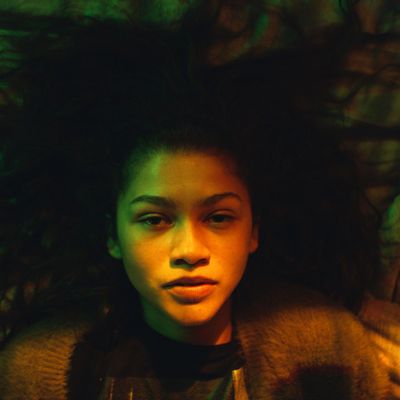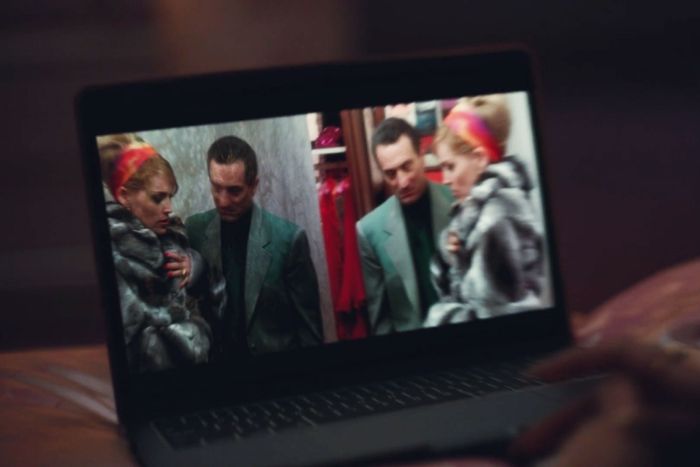
On HBO’s new teens-behaving-badly series Euphoria, seemingly anything can happen: an impromptu animated interlude visualizing one character’s homoerotic One Direction fan fiction, a gobsmacking montage of dicks upon dicks upon dicks, or, as in the recent episode “ ’03 Bonnie and Clyde,” a cameo appearance from the one and only Sharon Stone — of a sort, at least. Stone shows up in video form when unmotivated Maddy (Alexa Demie) watches Casino at home one night. Materialistic, hypersexual, and adept at playing with men, Maddy immediately identifies an aspirational figure in Stone’s Ginger McKenna, the hard-living girlfriend to Robert de Niro’s Mafia associate Sam “Ace” Rothstein. As in Maddy’s relationship with her own squeeze Nate (Jacob Elordi), she overlooks the elements of abuse between them and focuses on the fever-pitch life-or-death romanticism. She watches wide-eyed as Sam apologizes for his latest outburst by gifting Ginger a lavish chinchilla coat, mentally adding it to her vision board labeled “#goals.”
It’s the first time that the series has explicitly invoked the work of Martin Scorsese, but that allusion may have tipped off viewers to a spirit of homage that’s been running throughout the first season. Creator and showrunner Sam Levinson made waves with last year’s feature Assassination Nation, a film with trace amounts of Taxi Driver in its cinematic DNA, and he’s carried that same reverence for American filmmaking’s premier poet of self-destruction to his latest project.
Euphoria adopts many of Scorsese’s methods in pursuit of his same artistic goals, employing a hyperkinetic style to communicate the seductive quality of moral deformity. But where the auteur behind such dissections of the soul as Raging Bull and The Wolf of Wall Street has focused on mobsters and other crooks, Levinson and his stable of directors find inspiration in Generation Z. (He tapped a handful of women — longtime-House-star-turned-helmer Jennifer Morrison, Pippa Bianco of HBO’s upcoming teen-peril movie Share, Never Goin’ Back’s Augustine Frizzell — with simpatico ideas about adolescent rambunctiousness and visual maximalism to help realize his vision for the show.)
Like the pill-popping kids depicted onscreen, the show itself exhibits a streak of reckless abandon that can sometimes get away from it as it follows a not-so-easily emulated example. To depict without endorsing is tricky stuff — every new Scorsese release reignites the debate over whether he inadvertently glamorizes that which his films aim to condemn — and Levinson’s effort to do so for an audience reared on a steady diet of Billie Eilish music videos and TikTok clips illustrates just how fraught that mission can be.
The continued campaign of recovering addict Rue (Zendaya) to remain sober and stable constitutes this show’s central load-bearing beam, and Levinson spares no expense to ensure that his audience understands precisely how strong the narcotic variety of desire can feel to those in its grip. His camera shamelessly leers at pills and powders, as Rue goes into explicit detail on their usage and psychotropic benefits in the sedate monotone of a mumble-rapper. Scorsese, a man with a filmography steeped in the supercharged jitter of cocaine, similarly frames drugs with a gaze so sensuous as to border on the pornographic. The extreme close-up on the quaalude tablets tumbling onto the pool table during The Wolf of Wall Street’s under-the-influence brainstorming scene could have been clipped out of an episode of Chef’s Table set in a trap house.
In both cases, the rush of drug use bleeds into the formal fabric of the work as a whole. Scorsese and Levinson work the camera like they’re sharks, guaranteed to die if they stop moving even for a moment. NYU-film-school alumnus Scorsese nicked the best moves of the French New Wavers, translating their whip pans and snappy zooms for a new vocabulary of domestic pop cinema. A couple generations later, Levinson ransacks Scorsese’s playbook for Euphoria, starting with the absolute commitment to constant motion. The camera continually lurches back and forth, left and right, with quick-cut dolly shots to hustle us along through menial moments like a football player’s push-up training or shot/reverse-shot conversations. Every stylistic choice in Euphoria feels coordinated to make its 58 or so minutes of story feel as roller-coaster rapid as possible.
Levinson also shares Scorsese’s fondness for voice-over from unreliable narrators, tasking Rue with columns and columns of speedy exposition to keep the unloading of backstory kinetic. Levinson constantly indulges in elaborate crane shots of questionable utility; when the ensemble convenes at a carnival for a night of debauchery and drama, Levinson stages an almost ostentatiously complicated shot that careens from ground level into the air and back down to earth, as if for no other reason that to show that he can.
And the music, by God, the music. Scorsese all but invented the way modern Hollywood drops the needle, creating indelible moments with help from solid-gold oldies like the Crystals and rock epics from the Rolling Stones. Wielding what must be a truly bonkers licensing budget, Levinson packs every hour of Euphoria with wall-to-wall music, alternating between over-the-top operatic scoring and immaculately selected soundtracks. Though this week’s “The Next Episode” makes use of the Flamingos’ haunting rendition of “I Only Have Eyes for You,” he mostly trades the Scorsese songbook for choice cuts of hip-hop and electronica. An inebriated frolic in a pool mid-house-party attains momentary transcendence with the help of Bronski Beat’s “Smalltown Boy.” “Stuntin’ Like My Daddy,” mixtape-era Lil Wayne’s finest collaboration with regular associate Birdman, takes on a darkly ironic edge when paired with a plotline about a violent closet case discovering that his son has inherited his worst habits. (That song shares a title with the episode in which it appears, a behind-the-scenes convention foregrounding the music selections in the first six episodes, then seemingly abandoned for the upcoming final two.)
The barrage of kickin’ tunes leaves the viewer unprepared for the crushing swells of misery that arrive whenever the characters stop to consider themselves. Scorsese makes movies about people wrestling to overcome their demons, or more frequently, people skilled in the corrosive art of avoiding that very reckoning. His films work on a sin-penance-redemption cycle, and because television demands open-ended storytelling instead of a closed loop, Levinson’s writing flips between the first two parts. Teens, as is their wont, gravitate toward whatever provides temporary pleasure regardless of the long-term hurt. Drugs may be the primary example, but the Scorsesean penchant for vice also extends to no-good lovers like Maddy’s tormentor Nate and sexual gratification as a numbing agent. There’s a trendy sort of nihilism in the liberal passages of neon-hued partying that’s not totally foreign from the dissolution of Travis Bickle before he decides to straighten up and assassinate a political candidate.
What’s made Scorsese widely heralded as the greatest working director in America, or the globe, is his ability to balance the equations in his ethical calculus. His titillations with sex or violence always come followed by a gut punch to the soul, in which bad people get away with it and we have to sit with the wrongness of the world. Succeeding in this game comes harder for Levinson, partially due to his own limitations and partially due to those of his medium. For one, someone so apparently enamored of shock value can’t afford to photograph the profane and the banal with the same flashy flourishes, because eventually, it’ll all blend together in terms of dramatic gravity. But TV exacerbates the issue by forbidding full resolution, necessitating an unending supply of new provocations and with them, justifications for their existence. With the already-greenlit second season, Levinson will have to sidestep the trap that later seasons of American Horror Story fell into, as longevity grows into the enemy of edginess and freshness.
Levinson expresses a varied palette of references on Euphoria, though that’s kind of to be expected when your dad is the guy who made Diner. This past Sunday’s installment falls on Halloween, and the costumes nod to Weimar idol Marlene Dietrich, Abel Ferrara’s rape-revenge gem Ms. 45, and Patricia Arquette in True Romance. (The show follows a proud tradition of teen programming clearly informed by the taste of the 30-somethings making it.) But Scorsese remains the impossible high this show can’t stop chasing, a clean full-body mellow that never goes too far by losing control of its imagery. Though his shit can sure pack a wallop, ultimately, Levinson’s peddling a stepped-on imitation of the pure uncut.





